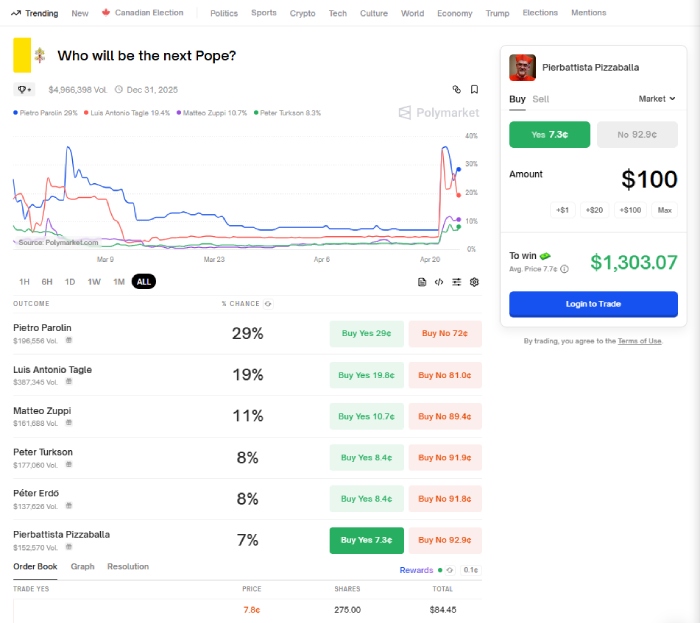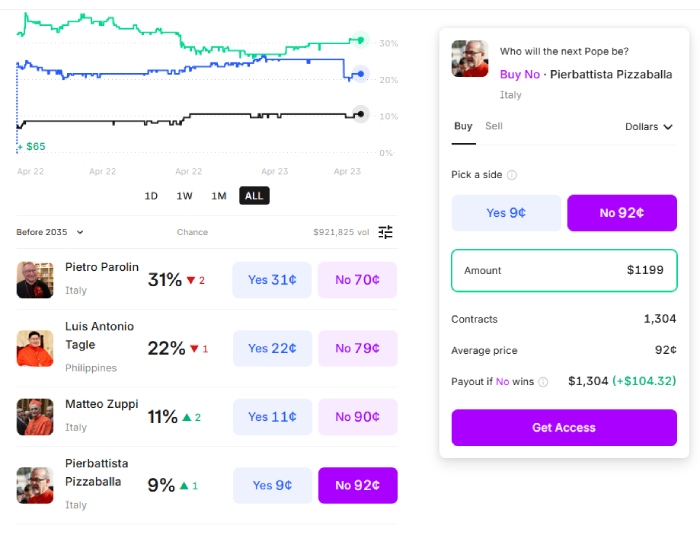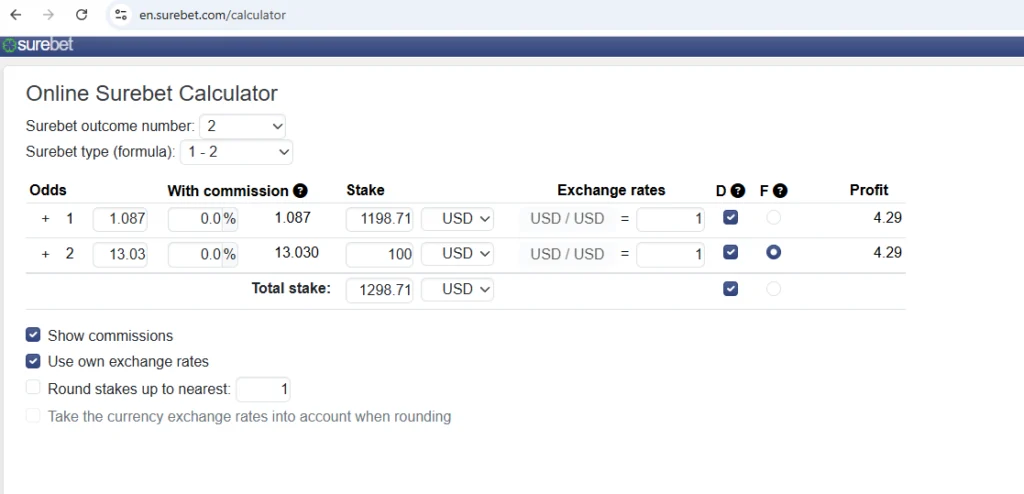Prediction Market Arbitrage Betting
Arbitrage betting on prediction markets can be seen as an alternative to sports arbitrage.
Anybody who has tried arbing (arbitrage betting) on sports has been limited/banned by bookies.
These prediction markets offer a new way of making guaranteed profits, but they also have some significant downsides.
Let’s dive in and find out what your possibilities are on these platforms.
Example for arbitrage on prediction markets
The opportunities offered by prediction markets are fairly easy to find at the moment. The moment I opened the most trending prediction (who will be the next pope), I found an arbitrage opportunity.
The first clue to find an arbitrage opportunity is checking the %chance difference between the sites.

At Pierbattista Pizzaballa, I saw a 2% difference, and after adding up the prices, I was sure there was an arbitrage opportunity.

By placing a bet on Polymarket on the price of 7.3 and betting against him on Kalshi on the price of 92, you could earn a guaranteed profit.
How to calculate the stakes?
As someone with a background in arbitrage betting, I wasn’t looking for a prediction market-specific calculator.
I fired up the arb calculator of surebet.com and checked the odds at the platforms. By inserting a stake of 10 or 100, you can see the decimal odds format of prices from the prediction market.

The price of 7.3 meant a decimal odds format of 13,03, and the 92 price meant the odds of 1,087.
The next step is calculating the right stakes so you can have the same profit no matter which outcome wins.
How to spot an arbitrage bet between prediction markets
To find arbitrage opportunities between prediction markets, you need to use the manual method.
At the moment of writing this guide, there are no arb finders that cover these sites. Hopefully, this will change in the future.
To find such arbitrages between these sites, you should open two or more of these services, find the same markets, and compare the outcome chances.
When there is a significant difference in % chance for an outcome, the probability of finding arbitrage increases.
Similarly to betting exchanges, each outcome has multiple prices and different liquidity.
You might find an excellent arbitrage opportunity on a prediction market, but the available liquidity will be only a few dollars.
On these, the arbitrage opportunity might grant you only half a dollar as guaranteed profit if you cover each outcome.
To maximize your profits, you might want to cover the outcomes at multiple prices.
With higher stakes on prediction markets, the prices increase significantly. This results in smaller profits, to the point of being a negative arbitrage.
Relevant for you > find the sharp odds based football predictions for today.
What are the advantages of arbing on prediction markets?
Prediction markets such as Polymarket or Kalshi will not ban you for exploiting arbitrage opportunities.
The available markets on these platforms are harder to predict correctly, so finding these opportunities manually is quite easy compared to sports arbitrage.
One of the biggest advantages of arbitraging between prediction markets is the liquidity and maximum stakes.
Many betting sites allow only a few hundred of $ as a stake for a minor market.
The 2024 presidential election was the best example of how profitable this type of betting can be. There were huge price differences between platforms, with the possibility of placing bets with high stakes.
The arbitrage opportunities were not as profitable as in sports betting, but you could bet several thousand of $ on 1%-2.5% arbitrages.
What are the dangers of arbing on prediction markets?
In my experience, the biggest downside of prediction market arbing is that you need to do it manually (at the moment).
This approach requires you to check the markets, compare prices, and calculate stakes manually.
Prediction market arbing is time-consuming right now.
A well-developed price comparison tool for these markets will cause discrepancies to drop and disappear in a few minutes.
The most significant danger of arbing on a prediction market is not covering each outcome for different reasons.
Such reasons can be: different evaluation rules between platforms.
For example, betting on elections where only two outcomes are available. You bet on person A at the first platform and person B at the other platform.
Person B withdraws from the election, and Person C (newcomer) wins. In this scenario, each of your bets might be lost.
Will prediction sites ban me for arbitrage betting?
Similarly to betting exchanges, prediction markets are arbitrage-friendly right now.
Which prediction market sites are the best?
At the moment, there are three significant prediction markets that have enough liquidity and are reliable: Polymarket, PredictIt, and Kalshi.
For more information, you can check the following dedicated comparison article:
- Polymarket vs Kalshi
Polymarket
Odds & Fees:
- No trading fees are charged.
- Charges no withdrawal fee when cashing out USDC.
- Built on Polygon: minimal network transaction fees.
- Considered the most cost-effective for all kinds of bettors.
Reliability:
- Operates in a regulatory gray area.
- No formal regulation poses risks such as market manipulation and legal uncertainty.
User Experience:
- Decentralized and blockchain-based.
- Uses USDC (crypto) for transactions, which may be a barrier for some.
- Offers a very broad and dynamic range of markets, including niche and humorous events.
- Capitalizes on social media trends to create betting events.
- High-volume and real-time data-driven.
PredictIt
Odds & Fees:
- High fees:
- 10% fee on profitable trades (applied to profits only).
- 5% withdrawal fee on any funds withdrawn.
- Considered the most expensive option.
Reliability:
- Operates within a regulated framework, mainly for political events.
- Has faced legal challenges impacting operations.
User Experience:
- Uses fiat currency, accessible to a broader (non-crypto) audience.
- Limited market variety.
- High fees reduce overall attractiveness, especially for high-volume trading.
Kalshi
Odds & Fees:
- Deposit/withdrawal fees vary by payment method: a 2% fee for debit cards for both deposits and withdrawals.
- Moderate cost structure compared to others.
1. Trading Fees (for all markets except certain listed ones):
- Charged only when an order is immediately matched (i.e., it takes liquidity).
- Not charged for unmatched orders that remain on the order book (unless part of Maker Fees).
- Formula:
fees = round up(0.07 × C × P × (1 - P))- C = number of contracts
- P = contract price in dollars (e.g., 50¢ = 0.5)
- round up = rounds to the next cent
Example:
- Buy 10 contracts at 0.60 (60¢):
fees = round up(0.07 × 10 × 0.6 × 0.4)= round up(0.168) = $0.17
2. Maker Fees (only for certain products listed by ticker):
- Charged for resting orders that are not immediately matched but later executed.
- Formula:
fees = round up(0.0025 × C) - No fee if the order is placed but canceled before being matched.
Example:
- Place 5 resting contracts that get filled:
fees = round up(0.0025 × 5)= round up(0.0125) = $0.02
3. Rebates for Rounding:
- If rounding causes the total fee to exceed the actual rate by more than $10/month, the excess is reimbursed the next month.
Rebate Example:
- Place 5 orders × 5 contracts = 25 total contracts
- Actual fee: 25 × $0.0025 = $0.0625
- Charged due to rounding: 5 × round up(5 × $0.0025) = 5 × $0.02 = $0.10
- Rebate = $0.10 – $0.0625 = $0.0375, rounded up to $0.04
Reliability:
- Fully regulated by the CFTC (Commodity Futures Trading Commission).
- Provides strong legal assurance and reliability.
User Experience:
- Uses fiat currency, appealing to more traditional users.
- User-friendly interface.
- More limited market selection compared to Polymarket.
Betting exchanges vs Prediction markets
I’ve been an active Polymarket user for years and really like the platform, mainly because there are no trading fees – it’s very +EV. I trade a lot of markets, and even small edges can be profitable.
Scalping works well here, unlike with bookmakers, where you always pay the spread. They even reward users for placing limit orders, though that might not last.
The main downside is the vague market rules. Disputes are common, and outcomes aren’t always consistent. New users often lose money this way, while regulars benefit.
I’m curious about Polymarket’s long-term plan. Exchanges aren’t as profitable as bookmakers.
I’ve heard they might pivot into a media company that uses prediction markets for more accurate news, but I’m not sure how they’ll monetize that.
I could see them launching a token that offers low fees if staked – classic altcoin move and a way for investors to cash out.
Betting exchanges in general charge high fees – Betfair’s 5% cut on winnings is huge. You need solid pricing skills or sharp trading to beat that. Another alternative is using betting brokerages.
Polymarket feels more active than Betfair, which is kind of a ghost town now. On Betfair, bad odds get matched, good ones don’t.
High fees also make exchanges less competitive with sharp books like Pinnacle. Polymarket’s no-fee model and tight spreads usually offer the best odds, so there’s a lot of action.
